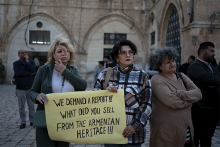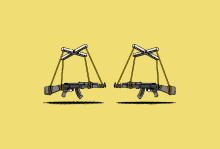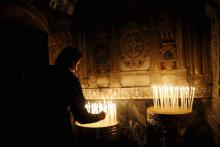armenian genocide

JERUSALEM'S OLD CITY has often been a focal point of the Israeli-Palestinian conflict, but within its walls lies a lesser-known story of occupation and resilience. The Armenian Quarter, a Christian enclave that has endured for centuries, now finds itself under threat.
In the context of occupied East Jerusalem, where Palestinians continually face displacement and erasure of their cultural and physical presence, the Armenian community’s struggle reflects a larger pattern. Though they make up a small portion of the city’s population, Armenians have called Jerusalem home for more than 1,700 years, surviving waves of conflict and colonial powers.
As a critical component of a shared Jerusalem between Jews, Christians, and Muslims, the Armenian Quarter has been a haven for this Christian community since a group of Armenian monks and priests established St. James monastery there in 420 C.E.
The enclave is now fighting to preserve its heritage amid mounting pressures. In April 2023, the community was shaken by plans from an Israeli-Australian developer, Xana Capital, to construct a luxury hotel on land purportedly owned by the Armenian Patriarchate. This development mirrors the land confiscation and settlement expansion that Palestinians know all too well.
Like the rest of the Christian population in the Old City, including the Greek Orthodox, Roman Catholic, and Ethiopian Orthodox, the Armenian community is navigating increased challenges, from economic strain to political pressures and demands to shift the historic status quo. These communities, increasingly pressured by Israeli authorities and settlers, face a myriad of problems, including property disputes, confiscation of church lands, new and prejudicial tax demands, and occasional acts of vandalism against religious sites. All Christian groups are grappling to maintain their historical presence in the face of growing threats in this contested city.

THE WAR BETWEEN Armenia and Azerbaijan this past autumn was an avoidable tragedy.
The disputed Nagorno-Karabakh region has been populated since at least the second century B.C.E. by Armenians, one of the world’s oldest Christian civilizations. The Muslim Azeris and others have lived there and in neighboring areas for centuries as well, and the region was ethnically mixed (albeit majority Armenian) when the Soviet Union collapsed in 1991.
Stalin’s divide-and-rule policy for drawing borders made Nagorno-Karabakh a theoretically “autonomous region” within the Azerbaijani Soviet Socialist Republic. As the Soviet Union was breaking up and Azerbaijani persecution of ethnic Armenians increased, the Armenian and Nagorno-Karabakh governments, with widespread support of their respective populations, demanded the transfer of the region to Armenia.
When Azerbaijan refused, Armenia seized the territory by force in the 1990s—along with large swaths of western Azerbaijan, populated primarily by Azeris, that were never part of Nagorno-Karabakh. Hundreds of thousands of Azeris, and a smaller number of Armenians, were victims of ethnic cleansing by both sides.

Francis’ trip to the site carries huge significance, following the pontiff’s description of the killings as “the first genocide of the 20th century.”

I spoke with James Tufenkian, founder of Tufenkian Foundation which serves to promote social, economic, cultural and environment justice in Armenia as it recovers from its genocide. I asked him about his connection with Sojourners, and how his work and faith intersect.
Ariana Denardo (AD): How did you get connected with Sojourners, and why did you decide to become a donor?
James Tufenkian (JT): My brother, a retired pastor, and I were having a series of conversations about the involvement of the church in social issues. He mentioned Sojourners, so I visited the website, read the magazine, and got interested. I found Sojourners to be the best, maybe the only organization I know of that works on social justice as Christians living out Christ’s example. It was natural for me to want to support that in different ways, one of them being as a donor.

One hundred years ago — April 1915 — as World War I raged across Europe, the government of the Ottoman Empire attacked its Armenian citizens. Over the next several years, it is estimated that as many as 1.5 million Armenians died. Able-bodied men were murdered or enslaved as forced labor in the army, and hundreds of thousands of women, children, the infirm, and the elderly were marched into the Syrian desert to face death.
Supported by the Young Turks, an ultranationalist party that approved systematic deportation, abduction, torture, massacre, and the expropriation of Armenian wealth, the German-allied Ottoman government used the excuse of war to initiate the forcible removal of Armenians from Armenia and Anatolia where they had lived for centuries.
The targeting and mass murder of Armenians has been termed a genocide.
Although racial, ethnic, and religious wars have killed millions over the centuries, genocide is a unique byproduct of the 20th century. It requires both a rabid nationalism and the capacity of a central authority to organize and implement a sustained and systematic program of targeted mass destruction. Not until the 20th century had governments the necessary technologies, resources, and means to ally their historical ethnic, religious, or racist hatreds with radical nationalism to end the collective existence of a people.
The Armenian genocide was recognized and deplored around the world, even as modern Turkey resists the “genocide” label. American diplomats, Russians, Arabs, and German officers stationed in Ottoman lands witnessed the slaughter and alerted the wider world. In May 1915, Great Britain, France, and Russia vowed to hold the Turks personally responsible for their crimes. Relief efforts to save the “starving Armenians” were widespread.